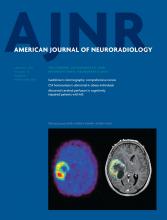Abstract
BACKGROUND AND PURPOSE: Oligodendroglial tumors with 1p/19q LOH are known to show longer patient survival than those without 1p/19q LOH, but the reason for this clinical difference has not been elucidated, to our knowledge. This study was designed to clarify whether uptake of MET correlates with 1p/19q LOH of oligodendroglial tumors.
MATERIALS AND METHODS: This study included 102 consecutive patients with supratentorial WHO grade II and III oligodendroglial tumors (39 oligoastrocytic and 63 oligodendroglial tumors) that were resected and diagnosed between January 2008 and August 2011 at Tokyo Women's Medical University Hospital. These patients underwent MET PET T/N ratio measurement before treatment. T/N ratios were calculated by dividing the maximum SUV for the tumor by the mean SUV of the contralateral normal frontal cortex. After surgery, FISH for resected tissues was used to determine 1p/19q LOH.
RESULTS: The mean T/N ratio of tumors with 1p/19q LOH was significantly greater than that of tumors without 1p/19q LOH (P = .0166). The threshold T/N ratio value of 2.46 was found to correlate significantly with 1p/19q LOH by univariate (P = .0011) and multivariate analyses (P = .0209) in all tumors.
CONCLUSIONS: The T/N ratio on MET PET might be a useful aid to the diagnosis of 1p/19q LOH. Our data add new information on the biology and imaging characteristics of oligodendroglial tumors with 1p/19q LOH.
ABBREVIATIONS:
- FISH
- fluorescence in situ hybridization
- LAT1
- l-type amino acid transporter
- MET
- 11C methionine
- MIB1
- mindbomb homolog 1
- 1p/19q LOH
- combined loss of heterozygosity of chromosomes 1p and 19q
- SUV
- standard uptake value
- T/N
- tumor/normal
- WHO
- World Health Organization
- © 2013 by American Journal of Neuroradiology












